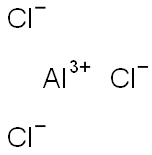Chemical Properties
Clear colorless to yellow solution
Chemical Properties
The aluminum alkyl halides are flammable, reactive, and may be spontaneously combustible in air. They are colorless to yellow liquids. Ethylaluminum dichloride:(563-43-9):
Uses
Ethylaluminum dichloride is used as a catalyst component in the polyolefin industry, for the synthesis of synthetic rubbers and for the dimerisation of olefins. It is also employed as a catalyst for Friedel-Crafts acylations.
Uses
Catalyst for olefin polymerization, aromatic
hydrogenation; intermediate.
General Description
A colorless to light-yellow heated liquid. Freezing point 90°F.
Air & Water Reactions
Highly flammable. Ignites when exposed to air. Reacts violently with water or moisture in air forming hydrogen chloride fumes and flammable ethane gas (Rose 1961).
Reactivity Profile
Organometallics, such as ETHYLALUMINUM DICHLORIDE, are reactive with many other groups. Incompatible with acids and bases. Organometallics are good reducing agents and therefore incompatible with oxidizing agents. Often reactive with water to generate toxic or flammable gases. Organometallics containing halogens (fluorine, chlorine, bromine, iodine) bonded to the metal typically with generate gaseous hydrohalic acids (HF, HCl, HBr, HI) with water.
Hazard
Ignites on contact with air, dangerous fire
risk, reacts violently with water. Skin irritant.
Health Hazard
Inhalation of smoke from fire causes metal-fume fever (flu-like symptoms); acid fumes irritate nose and throat. Contact with liquid (which is spontaneously flammable) causes severe burns of eyes and skin.
Potential Exposure
These materials are used as components of olefin polymerization catalysts. The reader is referred to the entry on “Aluminum alkyls” for additional information on this entry. The aluminum alkyl halides parallel very closely the aluminum alkyls
Shipping
UN3052 Spontaneously combustible. Water reactive releasing large quantities of toxic and deadly hydrogen gas. (Note: this number does not appear in the 49/CFR HazMat tables)
Incompatibilities
The aluminum alkyl halides are strong reducing agents; they react—possibly violently—with oxidizers (chlorates, nitrates, peroxides, permanganates, perchlorates, chlorine, bromine, fluorine, etc.); contact may cause fires or explosions. Keep away from alkaline materials, strong bases, strong acids, oxoacids, epoxides. These chemicals react violently with nitromethaneEthylaluminum sesquichloride reacts explosively with carbon tetrachloride at room temperature. This chemical reacts violently with water, forming corrosive hydrogen chloride and flammable ethane gas. Diethylaluminum chloride may form an explosive product with chlorine azide.










